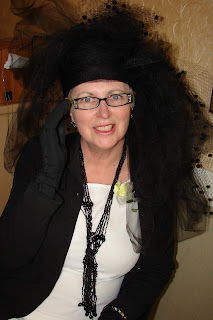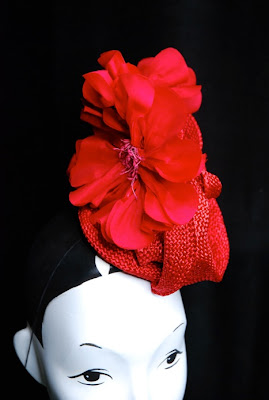See and Be Seen in
Vintage Eyewear
Monocles, horn-rimmed spectacles, and opera glasses have
long been appreciated by antiquities
dealers, but merchants at flea markets and vintage shops are now selling iconic
eyewear styles from the 1940s to the 1970s in Lucite, bakelite, woodgrain,
etched aluminum, painted metal etc. From Riviera
style to librarian temples, new old stock frames are trading briskly on the
internet and quirky, used glasses in octagonal and butterfly designs as well as
oversized sunglasses, disappear daily from thrift store shelves. In fact, not
since John Lennon first sported Granny Glasses have outdated lenses been so
collectible. With optical outlets recreating fashion classics like the
rhinestone studded cats-eye frames of the 1950s, and fashionistas embracing
that 70s look with big, round sunglasses, savvy collectors are taking pains to
source out authentic originals.
Eyewear collectibles can be found at flea markets and
antiques malls or any venue that specializes in small personal items. Use them
to enhance a vintage costume collection, or wear them by having the frames
refitted with custom lenses.
Fun and Funky Retro
Sunglasses turn up frequently at thrift stores and flea markets for between
five and fifteen dollars. Display them on a mirrored tray of the same vintage,
or use them to add authenticity to a collection of outdated swimwear.
Children’s sunglasses of the 50s and beyond mirror period adult styles, but
were also manufactured in a wide range of novelty motifs. These provide
personality when fitted on teddy bears or large dolls. Kids love them for
dress-up, or slip these inexpensive items (two to five dollars) into goodie
bags for a birthday party take-home treat. But beware; early examples do not
offer UV protection.
Price and Value: The
highest values are placed on iconic period pieces with jeweled or precious
metal frames and those which bear designer labels (Pucci, for example), or can
be proven to possess a celebrity association. Early items, such as turn-of-the-twentieth-century
wire rim spectacles, are abundant and can often be purchased for as little as
ten dollars, but even plastic, oversized sunglasses from the 1970s can set you
back a few hundred dollars if purchased from a dealer specializing in fashion
frames. Expect a mid-range price of $40 - $70 for men’s and women’s browline
styles from the 1950s.
Eyeglass Retrospective
by Nancy Schiffer is a good resource for evaluating classic eyewear, but period
magazines ads also prove helpful when dating these items. If your glasses are
found in their original case consider yourself lucky; these will give clues to
the age and origin of your purchase, but unfortunately many flea markets and
thrift stores separate the cases from their contents.
Brief History of
Glasses
While the use of glass magnifying lenses for reading can be
traced to thirteenth-century Italy, modern eyeglasses, i.e. lenses encased in
frames that can be worn on the face, have undergone many style changes since
the appearance of the pince-nez or
nose glasses of the eighteenth century, when lenses connected over the nose by
a bridge of light-weight tortoiseshell were popular with the upper classes.
Magnifying lenses mounted in watch fobs, walking sticks, and fans were also
fashionable for a time, and are a rare but exciting find for today’s
collector.
Early spectacles were unframed and simply held by hand in
front of the face, attached to hats, or tied around the head with bands made of
leather, ribbon, or cord. In China,
weights were added to strings, which looped over the ears holding lenses in
place. Style changes, particularly in the twentieth century reflect scientific
advances in the manufacture of lenses as well as frames, and are closely tied
to fashion and cultural influences.
What to Look for:
- 1870 –
1920: Windsor style spectacles
framed in gold, nickel, steel, or silver.
- 1900-1920:
Wire-rimmed lenses.
- 1920s:
Large lenses, tortoiseshell frames.
- 1930s:
Horn-rim or early plastic frames, round lenses.
- 1940s
& 50s: Cats-eye or harlequin glasses with etched, jeweled or decorated
frames.
- 1950 –
1970: Rare, special order aluminum frames, often hand-engraved.
- 1960s:
Round lenses, lightweight plastic frames, arched temples.
- 1970s:
Dropped temples, tinted lenses.
A Brief Glossary of
Styles and Terms:
Brow-line Frames: These were made for men and women in the
1950s and 1960s, and are comprised of a plastic casing over a metal frame.
Glassless Glasses: Glassless frames; a short-lived Hippy fad
of the 1960s.
Granny Glasses AKA Ben Franklin Glasses: Wire-framed round
or square glasses, fitted with colored lenses; a look popularized c.1965 by
Roger McGuinn of the Byrds and John Lennon.
Horn-rim: An early plastic designed to mimic natural
elements like baleen. (These become brittle over time and should not be exposed
to sunlight).
Jealousy Glasses: Miniature, side-looking mirrored
telescopes for observing people in secret. Some early 19-century French
versions were fitted with pill receptacles and scent bottles.
Lorgnette AKA Quizzing Glasses: A hand-held, single lens
device with a long stem or wand.
Monocle: A single lens held in place by the muscles of the
eye socket. These were usually custom made for the owner. Introduced in the 18th
century, these were popular with British aristocracy.
Opera Glasses: Opera glasses in sizes small to large, were
first introduced c. 1800. Look for two styles; rigid construction, and a
folding bridge style. Many are decorative, if not heavily gilded, having been
designed for Victorian and Edwardian theatre goers and sold in jewelry stores
or engraved and given as gifts. Those in their original case or inlaid with
mother-of-pearl will fetch higher prices.
Prospect Glasses: Miniature telescopes; popular with the
upper classes in the 18th-century as an alternative to wearing
spectacles.
Scissor Glasses: Ornate folding glasses popular with the 18th
century French court.
Wig Glasses: These 18th-century glasses with
temple wires were held in place by the powdered wigs worn by aristocrats.
Windsor Eyeglasses:
Metal-rimmed round lenses with temple arms that loop behind the ears. Think
Harry Potter.
While iconic eyewear from the mid-twentieth century is still
widely available at modest prices, its popularity is increasing due to its
intimate association with pop-cultural influences. When getting into the
market, consider wing-shaped frames that mimic the jet-age inspired tailfins of
the 1950s automobiles, or tuck-away folding lorgnettes that were carried in small
handbags by the cocktail-party generation. Whatever your selection, this is one
area of collecting that deserves a second look.






















